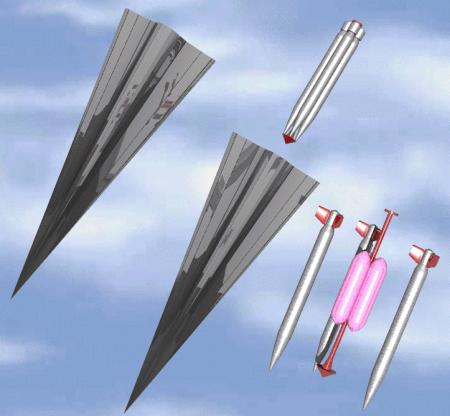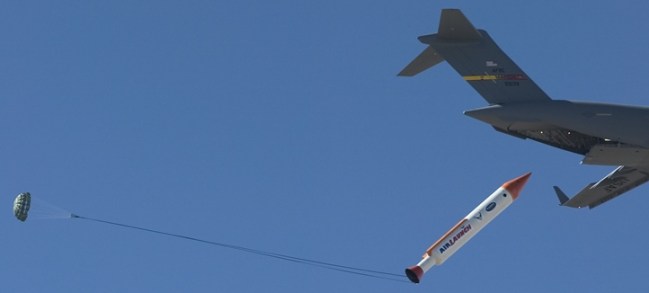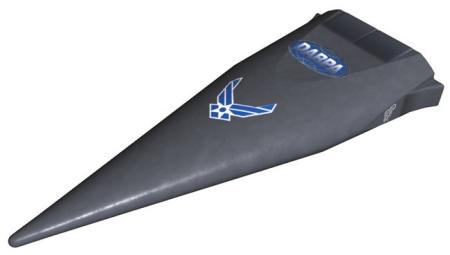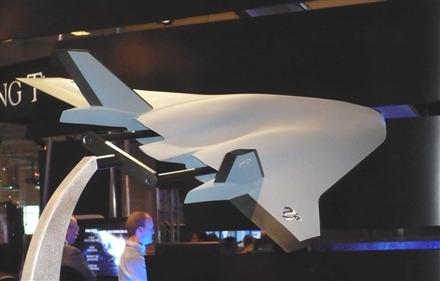X-41 CAV
(USAF/DARPA Falcon Program)
In the 1996/1997 time frame, the U.S. Air Force began to define plans for building blocks of a future Military Spaceplane (MSP) system. The full scope of these plans came to public attention in January 1998, when the Air Force Research Laboratory (AFRL) Space Vehicles Directorate (VS) requested proposals from the industry to study various aspects of advanced military space technology. This included research related to a potential MSP system. The latter was to cover concepts for RLVs (Reusable Launch Vehicles), SMVs (Space Manoeuver Vehicles, see X-37/X-40), so-called CAVs (Common Aero Vehicles), and pop-up upper stages (see X-42/USFE).
A CAV was defined as a manoeuverable hypersonic reentry vehicle, which can dispense a variety of payloads inside the atmosphere. CAV payloads could include multiple precision-guided penetrator warheads, which would use the CAV's high reentry velocity to achieve particularly deep penetration. The "Aero" in the name actually stood for "aeroshell" and not "aerospace", meaning that the CAV was a common aerothermodynamic shell for varying and multiple payloads. The CAV itself was to be launched into its suborbital trajectory either by expendable boosters or RLVs. At some time in late 1997 or early 1998, the designation X-41A was officially allocated to a CAV demonstrator vehicle. However, this designation has not been further used in any official announcements, and it's not clear if it was actually applicable to the CAV/HTV vehicle discussed below.
 |
| Image: NSSRM |
| Early CAV concept (1997/98) (weapon release sequence) |
Initial plans called for a CAV flight demonstration in 2003, and therefore it appears that the whole program proceeded a bit slower than originally anticipated (most likely because of insufficient funding). In December 2002, the Pentagon eventually directed the U.S. Air Force and the Defense Advanced Research Projects Agency (DARPA) to create a joint program which would merge the USAF's CAV and DARPA's Hypersoar projects. The latter's goal was to develop technologies for an HCV (Hypersonic Cruise Vehicle), a hypersonic long-range cruise missile. The new joint program was labeled FALCON (Force Application and Launch from Continental US), and consisted of two development tasks:
- Task 1: SLV (Small Launch Vehicle), a low-cost (US$ 5 million per launch) quick-response booster to launch the CAV and other small suborbital and orbital payloads
- Task 2: CAV, an unpowered hypersonic payload delivery vehicle (essentially the same as the USAF's original concept)
 |
| Image: DARPA |
| DARPA HCV design concept |
As the FALCON acronym suggested, one of the program's overall goals was the development of a quick-response global strike capability to any point on earth from within the United States. However, in 2004 the offensive strike part of FALCON was effectively cancelled, and the program name subtly changed to Falcon - no longer an acronym. The CAV had been renamed HTV (Hypersonic Technology Vehicle), and research on the weaponization of CAV/HTV was no longer a part of Falcon.
Falcon SLV
Note: The Small Launch Vehicle task of Falcon was of course not part of the X-41/CAV line of development. It is discussed on this page only to present the whole Falcon story in one article.
In Phase I of the SLV development effort, nine contractors received contracts to design an SLV. A downselect for Phase IIa in September 2004 reduced this to four competitors: AirLaunch LLC, Lockheed Martin Corp., Microcosm Inc., and Space Exploration Technologies Inc. (a.k.a. SpaceX). One or more of the Phase IIa contractors were to receive a Phase IIb contract for detailed design and further risk reduction. Phase IIc, originally planned to start in 2007, included an actual SLV launching a small satellite into orbit. By the end of 2005, Microcosm has been dropped from the competition while the Lockheed Martin effort has apparently not resulted in tangible hardware.
SpaceX Falcon 1
SpaceX's entry in the SLV competition was the Falcon 1, the smallest member of their projected Falcon family of launch vehicles. The name of the rocket family is somewhat confusing, because the larger members are in no way related to the USAF/DARPA Falcon program. The Falcon 1 is a two-stage liquid-fueled rocket using a SpaceX Merlin (1st stage) and a SpaceX Kestrel (2nd stage) engine. It is about 21.3 m (70 ft) long, has a diameter of 1.7 m (5.5 ft), a lift-off mass of 27200 kg (60000 lb) and a first-stage thrust of 342 kN (77000 lb). It is designed to lift up to 570 kg (1260 lb) into low earth orbit. The first flight was first attempted on 27 November 2005, but this launch attempt, as well as the next two on 19 December and 9 February, were aborted because of technical problems. Finally, the first launch occurred on 24 March, but the vehicle was lost due to a first-stage malfunction less than a minute after lift-off. The second flight on 20 March 2007 proceded well into the second-stage burn, but excessive roll then led to engine shutdown, and the rocket failed to achieve orbital velocity. The third test flight on 28 September 2008 finally succeeded in reaching orbit.
A further development, the Falcon 5, was to be 47 m long and have a cluster of five Merlin engines as the first stage and a Kestrel engine for the second stage whilst Falcon 9, with a length of 53 m, was to carry a cluster of nine Merlin engines as the first stage and a Kestrel as the second stage. Both the Merlin and Kestrel engines have been developed by SpaceX from scratch. Falcon 5 was abandoned, but Falcon 9 was developed into a very successful family of commercial space launch vehicles.
 |
| Photo: SpaceX |
| SpaceX Falcon 1 SLV |
AirLaunch QuickReach
As the company name suggests, AirLaunch LLC's QuickReach SLV concept used an aircraft as the "first stage" of its booster. The SLV was carried aloft inside a large transport aircraft (e.g. a Boeing C-17 or an Antonov An-124), released at altitude with the help of a parachute system, and then launched onto its trajectory. In October 2005, a dummy booster was used in a successful demonstration of the extraction procedure. The QuickReach booster was 20 m (65 ft) long, had a diameter of 2.5 m (97 in) and weighed up to 32700 kg (72000 lb) at launch.
 |
| Photo: via Defense Industry Daily |
| AirLaunch QuickReach SLV (dummy vehicle) |
Falcon CAV/HTV
After a Phase I evaluation of four competing CAV/HTV design proposals, Lockheed Martin received the sole Phase II contract in August 2004 to develop and build the HTVs for the Falcon program. The initial HTV design (HTV-1) was planned to be flight tested using an existing booster in September 2007, and was to reach a speed of Mach 19 at 30-45 km (19-28 miles) altitude. However, in May 2006 the construction of two HTV-1 vehicles was cancelled because subcontractor C-CAT had severe problems with delamination of the curved leading edges of the vehicle's aeroshell. The Falcon program instead proceeded directly to the HTV-2 (q.v. below).
 |
| Image: USAF/DARPA |
| HTV-1 |
Phase III of the Falcon program, originally planned to run from 2007 to 2010, was to further develop the HTV and integrate it with the SLV. The second and third generation HTV designs (HTV-2 and HTV-3) were to incorporate further improved aerodynamic configurations, thermal protection systems, guidance, navigation and control systems. The vehicles were going to be about 3.5-4.5 m long and weigh about 900 kg. HTV-1 through -3 designs had an increasingly "waverider-like" shape for increased L/D (lift/drag), increasing flight duration and re-entry cross range. HTV-2 was an expendable Mach 20+ design, but HTV-3 was to be a fully reusable vehicle with a design speed of about Mach 10 at 40000 m (130000 ft).
 |
| Image: DARPA |
| HTV-2 |
Two flight tests of the HTV-2 were conducted, on 22 April 2010 and 11 August 2011. Both used a Orbital Sciences (now Northrop Grumman) Minotaur IV Lite 2-stage suborbital launch vehicle. In both tests, contact to the HTV-2 was lost about 9 minutes into the flight, way short of the planned 30 minute hypersonic glide phase. An originally planned third test was subsequently cancelled, as was the development and test of the HTV-3 vehicle.
HTV-3X Blackswift
In August 2007, details of a Lockheed Martin Skunk Works program labeled HTV-3X emerged. Officially, it was a spin-off of the Falcon HTV-3 program, and was also called Blackswift. The HTV-3X was an unmanned reusable fighter-sized vehicle, which was to take off and land on a conventional runway and reach a speed of Mach 6. The powerplant was a turbojet/ramjet combined cycle engine, in which the turbojet accellerated the HTV-3X to Mach 3-4, where the ramjet took over. The turbojet part was said to be a larger version of the technology developed for the RATTLRS program.
 |
| Photo: Bill Sweetman |
| HTV-3X Blackswift (conceptual model) |
Further details about HTV-3X / Blackswift were essentially limited to unconfirmed rumours. However, in October 2008 the Blackswift program was officially cancelled. It seems that Lockheed Martin continued in-house work on the concept under the general label "SR-72", but no definitely confirmed information is available about how far this work actually progressed.
Specifications
No detailed characteristics about the Lockheed Martin HTV designs are available.
Main Sources
[1] DARPA Website (as of 2007)
[2] GlobalSecurity.org Website (as of 2007)
[3] Defense Industry Daily Website (as of 2007)
[4] SpaceX Website (as of 2007)
[5] Michael P. Kleiman:
High-speed air vehicles designed for rapid global reach, AFMC News Service, 27 January 2006
[6] Sharon Weinberger: Blackswift: Return of the Spaceplane,
13 August 2007
[7] Wikipedia: DARPA Falcon Project
[8] Wikipedia: Hypersonic Technology Vehicle 2
Back to Directory of U.S. Military Rockets and Missiles, Appendix 4
Last Updated: 25 August 2024